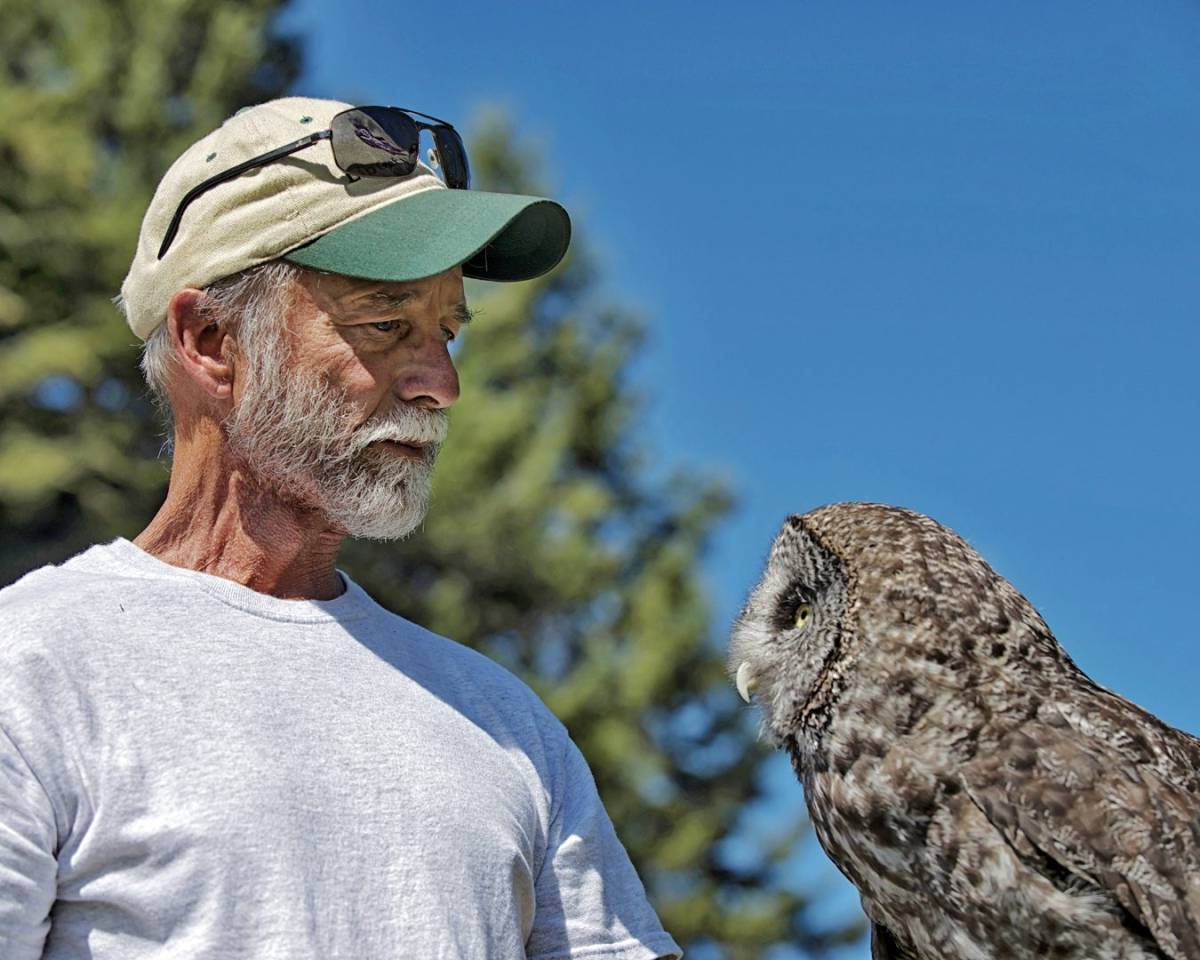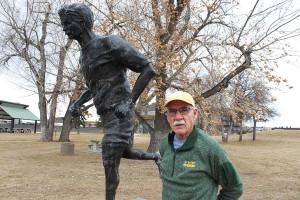by GAIL JOKERST
Photos courtesy of Doug MacCarter
Undoubtedly, childhood events shape lives, and Doug MacCarter’s career as a wildlife biologist testifies to that. During his teen years living in southeastern Montana, Doug’s capture of a four-legged bull snake—not a normal snake—indirectly influenced his future when the Billings Gazette ran an illustrated story about it. This drew the attention of a local wildlife biologist who happened to be a falconer. “He called and asked if I would bring the snake over to his house, which I did. It completely surprised him. All he could say was, ‘It had to be a genetic oops.’ He didn’t know how else to explain it,” recounts Doug, who was transfixed by the raptors he saw eye-to-eye at the biologist’s home.
Upon learning how eagles, hawks, and falcons could be trained, Doug’s curiosity took wing along with the birds themselves. Practically overnight, falconry replaced herpetology in his affections, and Doug’s interest in birds of prey, especially ospreys, has flourished ever since. “Ospreys are one of the most widespread raptors throughout Montana and the world. Where there are rivers, lakes, and streams—large or small—you’re going to find them,” says Doug. “They’ll nest by water if a platform or tree is nearby. If not, they will fly miles to water for food if necessary.”
As Doug explains, ospreys are the only hawk with three toes in front and one in back with the ability to reverse a front toe to the back, just like owls. This helps them clutch fish, which comprise 99% of their diet. Contrary to what some believe, Montana ospreys are not vying with wader-clad anglers for blue-ribbon catches. According to Doug, ospreys dive only about three feet below the surface for food, which is not where prized trout dwell. “For instance, Flathead Lake ospreys eat mostly trash fish – large-scale suckers, lake whitefish, squawfish, things that are not good to eat,” notes Doug. “Game fish are found much deeper.” Considering that for some 40 years Doug has observed and studied these treetop denizens throughout their lifecycle, he can make such statements with confidence.
During the 1960s he became concerned about osprey’s declining numbers nationwide. Rachel Carson’s book Silent Spring had alerted the world to the dangers of DDT, which worried Doug and his twin brother Don. Both held degrees in wildlife biology, so in conjunction with the University of Montana’s Flathead Lake Biological Station, they volunteered to conduct a 10-year study of osprey numbers. “Our intent was to see if ospreys in the West were reproducing at the same rate as those in the East. Populations were dwindling in both parts of the country,” Doug explains. “The two things we focused on were the effects of DDT and food resources. We found that food wasn’t a limiting factor but the use of DDT was.”
Spraying DDT and other insecticides to reduce mosquito and cherry-orchard fruit-fly populations had adversely affected the Flathead’s ospreys. Most critically, it affected their eggshells by making them thinner so they cracked more easily during parental brooding. With the eventual ban of DDT, osprey numbers rebounded to the point where Doug could dub it the icon bird of the Flathead Valley. “They’re so numerous and frequently seen because we have so many watershed areas,” declares Doug. “People know what osprey are but most probably couldn’t tell the difference between a hawk and a falcon.”
As you might imagine, conducting on-site raptor studies comes with its share of precautions and perils. Protective adult birds never welcome nest intruders of any ilk, for the sake of the nest as well as its inhabitants.
“It’s been said that ospreys have a stronger fidelity for their nest than for their mate. This is one reason I think they return to their nests,” says Doug, “especially if they’ve had a successful breeding season the previous year.”
Those tending eggs or chicks will leave the nest temporarily for two purposes: to go fishing or to gain enough elevation to dive-bomb the threat. “When doing our field research, one of us stayed on the ground watching for the adult’s return while the other one climbed to the nest and quickly counted and weighed the chicks,” recalls Doug. “If the adult reappeared, the spotter would shout a warning, and whoever was up the tree would hunker under the nest, which can be large enough to hold two men, to shield himself.”
Doug never had any close encounters of the dangerous kind with osprey parents. However, Don was not as fortunate. As Doug explains, ospreys attack in flight by balling their talons and aiming at the intruder’s head or shoulders. Don was surprised only once, but was stunned by the blow and almost lost consciousness. The brothers made sure that never happened again! Although DDT use is no longer an issue, seemingly innocuous discarded baling twine has become a problem. The bright colors attract the birds, who find the long lengths conducive to lining nests. Regrettably, the abandoned twine from fields and fence posts comes with sad consequences – it kills about 10 per cent of chicks and many adult ospreys. “Adults as well as chicks have sharp talons, which get tangled in the nest’s twine. It wraps around their legs, bodies, and wings. Since they can’t move, they either starve to death or accidentally hang themselves,” Doug explains. “Some nests have been found to include over a quarter mile of baling twine.”
Thankfully, the problem is fixable. Two of the most beneficial partnerships in working toward a solution formed last year when Doug sought help from Chris Hammond at Montana Fish, Wildlife, and Parks in Kalispell. Chris, in turn, asked Flathead Electric Coop if they would send linemen in bucket trucks to remove the twine from empty nests perched atop utility poles and platforms. The Coop gladly accepted and admirably met the challenge. While most of our readers do not own bucket trucks or have the inclination to shinny up cottonwood snags to clear nests, picking up discarded baling twine left on the ground or on fences and properly disposing of it is a simple and effective remedy. It takes just minutes to cut long strands into smaller pieces and throw them away somewhere invisible from an osprey’s perspective.
Every problem should be so easy to solve.
For an up-close glimpse of Montana ospreys, you can view live images of the nesting raptors at cams.allaboutbirds.org/channel/27/Hellgate_Ospreys or snappysportsenter.com/osprey-camera.html.











